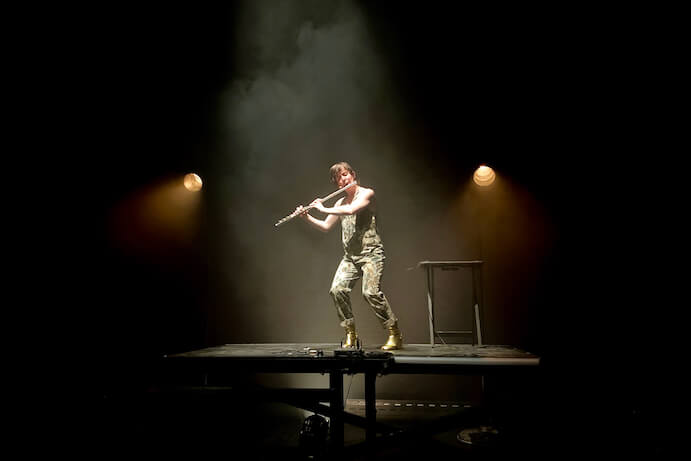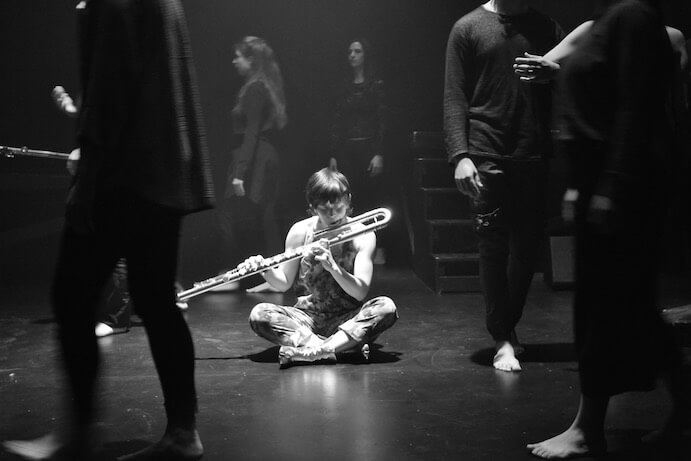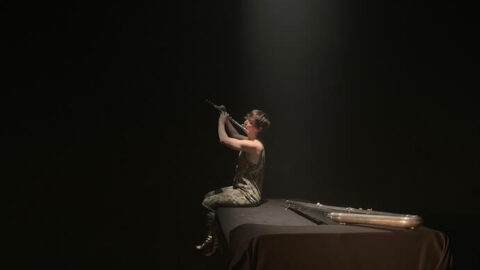Claire Chase‘s last “Density 2036“ episode, Marcos Balters’ Pan, was a 90-minute musical drama involving mass community participation, but her “Density 2036: part vi” at The Kitchen on March 1, 2019 returned to traditional black box for a performative recital and heightened production values. The 2018-2019 installment of Chase’s 23-year commissioning odyssey featured the work of Nicholas Houfek, production design; Levy Lorenzo, sound design; Saori Tsukada, movement advisor; and Pamela Salling, stage management, who together shaped seven disparate works into a cohesive theatrical prong for Chase’s signature shine.
This was no mean feat: the namesake Varèse piece Density 21.5 was the only solo work. Every other piece was solo flute plus a human or machine partner: typewriter, amplified heartbeat, choir, drum kit, electronics, tape, and interactive LED light sculpture all collaborated with Chase and her plethora of solo flutes. The opener, Magic Flu-idity, was a beautiful contrast of technology, soundscape, and performance practice. Chase used an iPad and Bluetooth pedal while almost dancing in a camouflage jumpsuit and futuristic gold boots, throwing out snatches of Baroque figures and modern techniques in the reduction of Olga Neuwirth’s flute concerto. Nathan Davis sat calmly opposite her, reading a paper score at a wooden desk and providing accompaniment from a typewriter, water glass, and librarian’s ping bell.

The Kitchen’s performance space had various ramps and platforms that, initially obscured by darkness and dry ice, were unveiled by excellent lighting design and choreography. Saori Tsukada deserves special acknowledgement for advising movement that turned Pamela Z’s Louder, Warmer, Denser into an intimate scene between the flutist and her instrument. Props to Chase for turning a platform crawl into a romance and playing contrabass flute lying down. In Phyllis Chen’s Roots of Interior, Chase showcased an almost reptilian athleticism before moving into profound stillness as a digital stethoscope revealed her heartbeat.
Next, she took a seat to anchor Sarah Hennies’ aptly named Reservoir 2: Intrusion. Constellation Chor entered and diffused Chase’s solo energy into muted layers and overlapping chants. As Chase played a repeated motif, members of the choir walked at random until their path intersected with another singer. They would perform a kind of choreographed conversation, exploring elbows and kneecaps in a stilted platonic handshake of friendship. Hennies’ piece makes one aware of their own breathing and summons goodwill in human overtures.

The “Density 2036: part vi” program commissioned female composers Olga Neuwirth, Pamela Z, Phyllis Chen, Sarah Hennies, and Bahar Royaee, and Tyshawn Sorey presented a revised version of his 2016 Bertha’s Lair. Royaee’s piece, Purge, represented the formal educational initiative of “Density 2036,” which is central to Pnea Projects, a nonprofit organization founded by Claire Chase dedicated to expanding contemporary flute music. Pnea plans to launch a digital Pnea Library in fall 2019 with all Density scores, performance materials, and media to date, continuing through the completion of “Density” in 2036. Pnea biannually awards a young flutist and young composer for their exceptional promise and inventive work for flute, and Royaee is the most recent winner of the Pnea Prize for Young Composers.
Chase’s dramatic performances and dynamite virtuosity are applauded staples of the hip scene, but it’s hard to imagine them in traditional educational settings. Perhaps that’s the point for music education hungover from industrial labor and largely defunct orchestral opportunities. Chase can’t single-handedly pull classical music into the 21st century, but for now, she prophesies what’s possible and opens a portal as the tide turns.
























